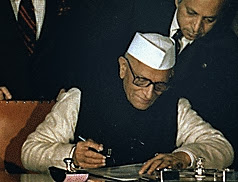Post Emergency scenario - Rise and fall of Janata Government
Elections declaredOn 23rd Jan 1977, Indira Gandhi announced elections to the Lok Sabha. Emergency...

Elections declared
On 23rd Jan 1977, Indira Gandhi announced elections to the Lok Sabha. Emergency was lifted on 23rd March 1977, after 21 months. After the declaration of elections, all the leaders were released from jail.
Formation of Janata Party
When the leaders came out, they did not have money or organisational structure. The workers were also in prison. Four major political parties Congress (O), Bharatiya Jan Sangh, Bharatiya Lok Dal and Socialist party were merged to form 'Janata Party'. All of them contested under the same symbol of 'chakra-haldhar'. Lok Nayak Jayaprakash Narayan brought all the leaders together to fight against Indira Gandhi.
6th General Elections - 1977 - Janata Government formed
Times of India report on Indira Gandhi resignation |
In the General Elections, Janata Party and its allies swept the polls by getting 345 seats out of 542 in the Lok Sabha. This constituted 51.9% of polled votes. 60.5% of voters participated in the elections. The newly formed Janata Party alone secured 295 seats (41.1% vote share).
Congress and other alliance parties could win only in 189 seats (41% vote share), that too in the four states of South India. In the North India, Indira Gandhi got only 2 seats. Both Indira Gandhi and Sanjay Gandhi were defeated. Indira Gandhi apologized for the emergency excesses and atrocities.
Morarji Desai, the 4th Indian Prime Minister
Janata Party leaders |
After the Elections, the first non-Congress Government after Independence was formed with Mr Morarji Desai as the 4th Prime Minister of India on 24th March 1977. Babu Jagjivan Ram and Chaudhary Charan Singh were designated as Deputy Prime Ministers. Atal Bihari Vajpayee, L K Advani and many senior leaders were the Cabinet Ministers. This cabinet is still considered as one of the best cabinet with eminent persons and expertise.
Before the swearing in ceremony, all the leaders of the newly formed Janata Party pledged at Mahatma Gandhi Samadhi, in the presence of Lok Nayak Jayaprakash Narayan to run the Government with unity.
Morarji Desai |
During the emergency days, Indira Gandhi made a constitutional amendment (known as 42nd amendment) crippling the constitutional powers. But after Janata Party came to power, they reversed all the amendments, to restore the supremacy of the Constitution. (popularly known as 44th amendment).
Appointment of Shah Commission by Janata Government
Janata Party formed the Government under the Prime Ministership of Morarji Desai. They appointed a Commission under the Chairmanship of Justice Shah to enquire into the atrocities and excess committed during the Emergency period. Justice Shah also submitted his report in August 1978.
In September 1977, Indira Gandhi and Sanjay Gandhi were arrested for various charges. This arrest event created more sympathy to Indira Gandhi.
Fall of Morarji Government
Due to infighting among the merged parties, the Janata Government could not remain in power for the full term. Charan Singh, who was the Deputy Prime Minister, was lured by Congress to get the Prime Minister's post. He broke away from Janata Party with 64 members of erstwhile Lok Dal party, along with Raj Narain. Meanwhile, Bharatiy Jan Sangh also withdrew support to Morarji Government and broke away from Janata Party, to form the Bharatiya Janata Party (BJP). Morarji Desai lost the confidence vote in the Lok Sabha and resigned from Prime Ministership.
Charan Singh sworn in as PM
Charan Singh was sworn in as 5th Prime Minister on 28th July 1979 with the promised outside support of Indira
Charan Singh |
Charan Singh remained in office till 14th January 1980. He is the only Prime Minister in India, who never faced Parliament and remained in power for several months.
Very unfortunately, the Janata Government which came to power with the slogan 'democracy or dictatorship', could not continue for long, due to the internal differences and personal ambitions of the leaders.
Janata Party got split into various parties, like Janata Dal, BJP, Samajvadi Party, etc. Presently, Dr Subramaniam Swamy is the lone leader who remained in the original Janata Party. Now Janata Party is also merged with BJP. The party which ruled the nation once is no longer existing.
Post emergency era witnessed lot of political instability, with the emergence of various small parties holding regional powers. In the elections held in 1980, Indira Gandhi came back to power with more seats. In the next posting, we will look at her re-emergence and her assassination.
By Prime Point Srinivasan





.jpg)

